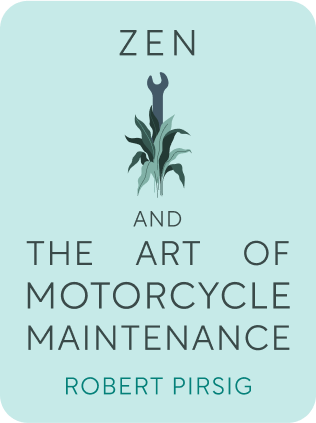

This article is an excerpt from the Shortform book guide to "Zen And The Art Of Motorcycle Maintenance" by Robert Pirsig. Shortform has the world's best summaries and analyses of books you should be reading.
Like this article? Sign up for a free trial here .
What does getting out of your comfort zone mean? Why is this so important?
In Zen and the Art of Motorcycle Maintenance, Robert Pirsig explains that discomfort is relative. He says that learning to live with discomfort and getting out of your comfort zone will improve your life.
Read more about Zen and the Art of Motorcycle Maintenance and getting out of your comfort zone.
Getting Out of Your Comfort Zone: The Chautauqua
The idea of getting out of your comfort zone is discussed in the chautauqua about discomfort.
Discomfort Is Relative
Pirsig’s argument for Sylvia’s joining them is that discomfort matters “only when the mood is wrong.” That is, if you’re already out of sorts—perhaps because you don’t want to be traveling—then discomfort assumes outsize importance. But if you’re happy to be traveling, whether because of the scenery or the company, then discomfort doesn’t bother so much.
Presently Pirsig spots a storm on the horizon. If it’s a cold front, the storm will be intense but short; if it’s a warm front, the bad weather could last for days. This is why getting out of your comfort zone is so important.
Be Careful of Assumptions
Pirsig recalls a past motorcycle trip—to Canada—with Chris when they endured a warm front. After a soggy night, during which water leaked into their tent and soaked their sleeping bags, they get caught in a particularly dangerous storm. With lightning striking around them, their motorcycle suddenly stops working. They sputter into a gas station, and Pirsig tries to diagnose the problem (at the time, he was like John—ignorant of motorcycle maintenance). He sees gas sloshing around, checks the engine parts—all looks good—but the motorcycle still won’t run. Eventually he’s forced to abandon the trip, much to Chris’s disappointment. Two weeks later, Pirsig has another look at the motorcycle to figure out what went wrong. He discovers the tank was out of gas—the sloshing he heard was the reserve tank, which he’d never turned on. He still kicks himself for this oversight.
John signs for Pirsig to stop and informs him that they’ve missed their turn. Rather than double back, they decide to press on. Once they’re back on the road, Pirsig’s anxiety ratchets up—he doesn’t know how he missed the turn, and he’s also forgotten to tell John and Sylvia about the storm. In preparation for what’s on the horizon—literally—Pirsig checks his motorcycle’s engine temperature with his hand.
Care for What You Do
Pirsig’s motorcycle, which is air-cooled, has a history of “seizing”—this is when the pistons expand from too much heat and lock the engine, sending the cycle into a skid. He reveals that the cycle he’s riding has seized three times before.
The first time the cycle seized, he brought it to a mechanic, thinking (at the time) that it wasn’t worth the investment and effort to learn what was wrong and repair it himself. The shop, in which a radio was playing loudly, was staffed by young men who seemed more interested in socializing with each other than paying attention to Pirsig. Finally a mechanic noticed him and took a look at Pirsig’s cycle. After only the most cursory analysis, he diagnosed the problem as the cycle’s tappets (which Pirsig knew was wrong).
Two weeks later Pirsig pays their hefty bill and has his cycle back. On his first ride it seizes again. When he brings it back to the mechanic, they accuse him of not wearing it in properly. The mechanics take the cycle back, fix it, and wear it in themselves. It seizes on them this time.
The mechanics decide to replace many of the core components of the engine, and when Pirsig returns to pick the cycle up, it’s covered in grease and doesn’t start. Pirsig discovers the plugs are disconnected; he connects them and now the tappets are making noise. When Pirsig points this out, a mechanic comes over and proceeds to ruin the tappet covers. Then, as the mechanic tries to remove the ruined tappet covers with a hammer and chisel, he further damages the engine. Finally Pirsig has had enough: “Just stop,” he says, and takes the bike as is.
On the road, the cycle vibrates violently at speeds over 20 mph. Pirsig pulls over and discovers that the mechanics had forgotten to bolt the engine in completely. It was attached by only one bolt.
A few weeks later he discovers what was causing the engine to seize: a sheared pin in the cycle’s oil-delivery system. The shear, Pirsig notes, was also caused by a mechanic, one that worked on the cycle before he bought it.
Why did the young mechanics butcher Pirsig’s motorcycle? Pirsig has three theses:
The radio. You can’t do thoughtful work while you’re listening to the radio. You can turn wrenches with the radio on, but you can’t think deeply about what you’re doing.
The speed. The mechanics were working too quickly. More customers means more money, so they were doing slapdash work on Pirsig’s cycle to make room for the next repair.
The (spectator) attitude. The mechanics were friendly, relaxed, cheerful—and entirely uninvested in what they were doing. They didn’t identify with their work, they just did it. Pirsig, who edits technical manuals for a living, sees the same thing in the texts he corrects—a kind of carelessness. Pirsig calls this approach to one’s work the spectator attitude. When we perceive our work like it’s alien to us, like it’s an entity isolated in time and space from ourselves and others, we can’t help but treat it superficially. Pirsig aims to explore the sources of the spectator attitude in his ruminations throughout his trip.
The travelers are in the Red River Valley, not far from the Dakotas, when the storm reaches them. They’ve already decided to ride until they can’t anymore, and Pirsig signals to John that they had better get a move on. He and John press the throttle on their cycles, accelerating up to almost 100 mph, as it gets dark from the storm clouds. Suddenly there’s a flash of lightning and a clap of thunder, then another, and Pirsig realizes “he” has been on this road before. Pirsig begins slowing down, even as Chris urges him to speed up and the Sutherlands disappear into the distance. Eventually Pirsig and Chris arrive at the town Pirsig says, somehow, he knew would be there.
More Advice on Getting Out of Your Comfort Zone
Chris’s question prompts Pirsig to extemporize on the nature of reality. Because ghosts are immaterial—they contain neither energy nor matter—they only exist in people’s minds (at least according to the laws of science). But, Pirsig points out, the laws of science too are immaterial—they contain no energy or matter and only exist in human minds as well. Thus Pirsig concludes that one should believe in neither ghosts nor the laws of science. They discuss more chances for getting out of your comfort zone.
Unsurprisingly, this conclusion causes some confusion among the group. Chris says a friend of his at camp believes in ghosts. When the adults ask about his friend, he indicates that his friend is American Indian. (Shortform note: The text’s representation of American Indians in this section is dated, and modern readers may find Pirsig’s characterizations distasteful, if not offensive.) The adults laugh, and Pirsig says that he was talking about European ghosts. This answer doesn’t satisfy Chris: he doesn’t understand the difference between Indian and European ghosts.
Suddenly Pirsig reverses himself and says he does believe in ghosts. His reasoning is:
American Indians and medieval Europeans weren’t any less intelligent or perceptive than modern humans. Rather it was the context in which they lived that caused them to believe in ghosts. To them, ghosts and spirits were as real as subatomic particles are to us.
Modern humans, scientific advances notwithstanding, have their own ghosts: scientific laws, the number system, algebra. These entities don’t appear in nature; they appear real to us because we believe they’re real.
When John objects, Pirsig offers a further example:
Did gravity exist before Newton discovered it? We’re naturally inclined to say “Yes, of course,” but Pirsig muddies the water. He asks John if the law existed before our galaxy formed, planets came into being, our earth and human beings appeared. When John demurs, Pirsig asserts that this argument, taken to its logical extreme, illustrates that the law doesn’t—can’t—exist without a human mind to create and understand it. And not only the law: gravity itself doesn’t exist before Newton.
What Pirsig is driving at is the primacy of mind in humans’ relation to the world. Mathematics, the laws of logic and physics, historical progress—all are human inventions designed to order and explain the world to us. In a very real sense, the “world has no existence outside the human imagination.” When we look at the world, we’re seeing it through the eyes of ghosts: Moses, Christ, the Buddha, Plato, Descartes, Jefferson, Einstein—the philosophers, sages, and scientists whose ideas about the world we accept as true.
The Sutherlands are dumbfounded by Pirsig’s theorizing, and, after a pregnant pause, the conversation turns to safer topics.

———End of Preview———
Like what you just read? Read the rest of the world's best book summary and analysis of Robert Pirsig's "Zen And The Art Of Motorcycle Maintenance" at Shortform .
Here's what you'll find in our full Zen And The Art Of Motorcycle Maintenance summary :
- How an unnamed narrator and his son are on a cross-country motorcycle journey
- Why technology can be creative
- How to focus on what's in front of you in order to get exactly what you need






